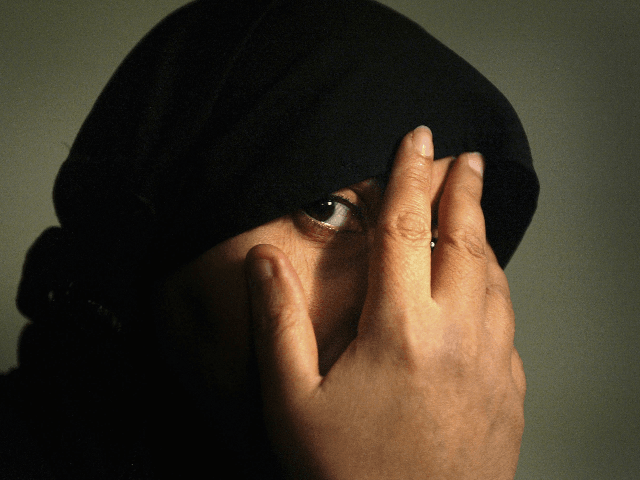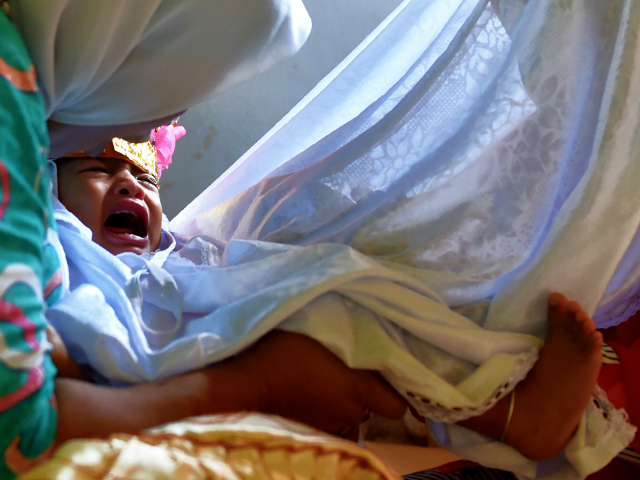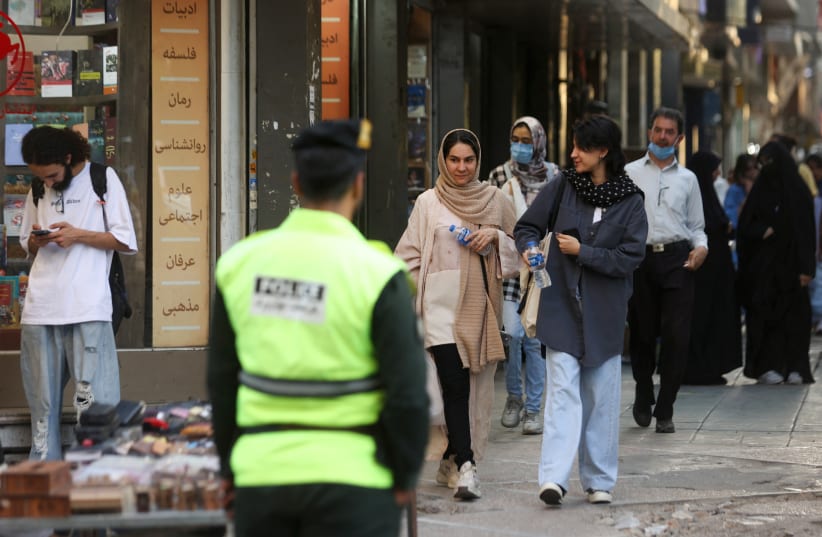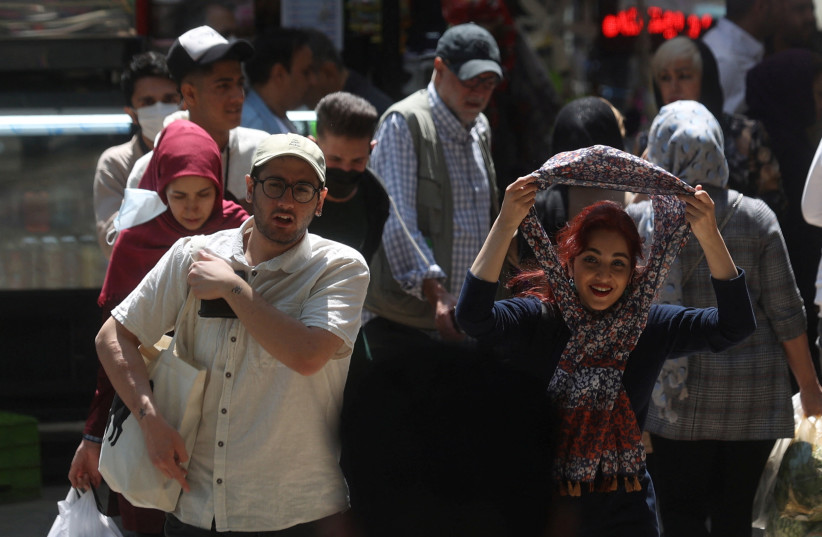STOP PLAYING TO MUSLIM BARBARISM.
Lawsuit: NYC to Pay $17.5 Million After Muslim Women Forced to Remove Hijabs for Mugshots

New York City has agreed to pay a whopping settlement after a pair of women claimed their rights were violated when they were forced to remove their hijabs for mugshots.
A hijab is not a full-body garment. It covers only the hair and neck.
The city said it will fork over the $17.5 million settlement, which still needs approval from Judge Analisa Torres of U.S. District Court for the Southern District of New York, the New York Times reported Friday.
The case surrounds a 2018 class-action lawsuit involving a pair of Muslim women identified as Jamilla Clark and Arwa Aziz.
“Damages from the settlement, which total just over $13 million once administrative costs and lawyers’ fees are deducted, will be split among the thousands of people who are expected to file eligible claims,” the Times report continued:
Ms. Clark, who was arrested on a violation of an order of protection in Manhattan in 2017, said she “wept and begged to put her hijab back on” while standing in Police Headquarters at One Police Plaza with the head scarf around her shoulders, according to the complaint.
Ms. Aziz, who was also arrested on a violation of an order of protection, said she had a similar experience eight months later when she was arrested in Brooklyn. She sobbed as she “stood with her back to the wall, in full view of approximately one dozen male N.Y.P.D. officers and more than 30 male inmates,” the complaint said.
“Each woman received a $60,000 settlement,” Breitbart News said, adding, “In Islam, it is considered sacrilegious to remove the headscarf of a Muslim woman by force. It is typical for only a Muslim woman’s husband or her family members to see her without her headscarf.”
A BBC report from February highlighted three Iranian women who are defying their country’s theocratic government by leaving their homes in the capital of Tehran without wearing head coverings.
One of the women, identified as 20-year-old Donya, said, “It’s very scary. Because they can arrest you any minute and fine you. Or torture you with lashes. The usual penalty if you’re arrested is 74 lashes.”
Global Female Genital Mutilation Cases Soar to 230+ Million

Cases of female genital mutilation (FGM) top 230 million worldwide and show no sign of slowing down, UNICEF said in a report released Friday, citing a dramatic increase of 15 percent since 2016 with most cases being reported in Africa.
FGM can include partial or total removal of the clitoris as well as the labia minora, and suturing of the vaginal opening to narrow it, in the incorrect belief the cut can control women’s sexuality and make them more likely to be obedient to religious and social restrictions.
The practice has been known to cause fatal bleeding or infections, and can also have long-term consequences such as fertility problems, childbirth complications, stillbirth and painful sexual intercourse, AFP reports.
“It is indeed bad news. This is a huge number, a number that is bigger than ever before,” said Claudia Coppa, lead author of the report released to coincide with International Women’s Day.
The AFP report sets out Africa is home to the most number of FGM cases with more than 144 million, ahead of Asia (80 million) and the Middle East (six million), according to the survey of 31 countries where the practice is common.

File/In this photograph taken on February 20, 2017, toddler Salsa Djafar cries as a healer conducts a circumcision, in Gorontalo in Indonesia’s Gorontalo province. (BAY ISMOYO/AFP/Getty)
“We’re also seeing a worrying trend that more girls are subjected to the practice at younger ages, many before their fifth birthday,” UNICEF chief Catherine Russell said in a statement.
“That further reduces the window to intervene. We need to strengthen the efforts of ending this harmful practice.”
The report also showed that four in every 10 survivors live in conflict-torn countries with high population growth rates, claiming political instability disrupts efforts prevent the practice and provide support to victims.
“Ethiopia, Nigeria and Sudan account for the largest numbers of girls and women who have undergone female genital mutilation in conflict-affected countries,” the report said.
FGM is usually carried out on young girls between infancy and the age of 15, most commonly before puberty starts.
In 2012 the U.N. passed a resolution to ban it but for the most part the globalist organization has been ignored.
Kurdish-Iranian woman whipped 74 times for not wearing hijab
As she was flogged, Roya Heshmati chanted "in the name of woman, in the name of life, the clothes of slavery are torn..."

A Kurdish-Iranian woman named Roya Heshmati was whipped 74 times after a photo of her was published a few months ago in which she was seen not wearing a hijab in Tehran, Iranian human rights activists reported on Saturday. Heshmati has been an outspoken critic of the Islamic regime’s hijab law.
In an account of the flogging shared by the Kurdish human rights organization Hengaw, Heshmati stated that upon entering the court where the flogging was to take place, she removed her hijab. Although both her lawyer and an employee advised her to put on her headscarf “to avoid trouble,” she recalled that she “came specifically for the lashes, and I would not yield.”
The officer carrying out the flogging told her to put on the hijab, but she refused, even after he threatened to whip her severely and add another 74 lashes to her sentence. “I maintained my stance and did not wear the hijab,” stressed Heshmati.
Eventually, two women came and forcibly placed a scarf on her head, eventually handcuffing her to keep the scarf on.
Heshamti described the room where the sentence was carried out as containing a bed with handcuffs and iron bands welded to both sides, as well as an iron device resembling a large easel which also had handcuffs and an iron binding in the center. “It resembled a fully-equipped medieval torture chamber,” said Heshmati.
Heshmati wrote that she quietly chanted, “In the name of woman, in the name of life, the clothes of slavery are torn, our black night will dawn, and all the whips will be axed... ” as the whipping was carried out. She added that she ensured that her pain was not perceived by those present and that she removed the headscarf as soon as she left the room.
“Inside the judge’s chamber, he acknowledged discomfort with the case but insisted on its implementation. I chose silence. He suggested living abroad for a different life; I affirmed our commitment to resistance, emphasizing the universality of this country. He insisted on legal adherence, and I urged the law to fulfill its role while we persist in our resistance,” wrote Heshmati.


Maziar Tatai, Heshmati’s lawyer, stated that Heshmati was originally arrested and had her phone and laptop confiscated for publishing a picture of herself without the hijab, according to Entekhab, an Iranian reformist news site recently blocked in Iran for criticizing the government.
Tatai added that the Iranian judiciary changed the charges placed against Heshmati several times throughout the process, including charges of “propaganda against the regime,” “being in the streets without a religious hijab,” “harming public modesty,” “producing vulgar content,” and “encouraging people to commit corruption.”
HESHMATI SPENT several days in jail and was issued a prison sentence which was later reduced.
Tatai noted that Heshmati’s flogging took place on Mother’s Day in Iran, marked on the birthday of Fatima Zahra, the daughter of the Prophet Muhammad and the husband of Ali, the first Shia Imam.
The Mizan News Agency, affiliated with Iran’s judiciary, confirmed that Heshmati had been whipped 74 times but stressed that she was not convicted for not wearing a hijab and was instead convicted of “promoting promiscuity” on the streets of Tehran after having received money from an organized movement abroad.
In another recent case, Zeinab (Bahar) Khonyabpour was sentenced to two years in prison for publishing photos in which she was not wearing a hijab, according to the Iranian HRANA human rights organization.
Iran intensifies enforcement of hijab laws
Despite temporarily relaxing enforcement of hijab laws after protests swept Iran in 2022 following the killing of Mahsa Amini, Iranian officials have since renewed their crackdown on women not wearing hijab, introducing new measures, including the use of surveillance cameras to enforce hijab laws.
Amini, a Kurdish-Iranian woman, was arrested by “morality police” officers in Tehran in mid-September of 2022 for allegedly incorrectly wearing her hijab, with her family saying that she was beaten by the officers in the van that brought her to the police station. Amini collapsed at the station and later died at the hospital.
Amini’s death sparked intense nationwide demonstrations, commonly referred to as the “Woman, Life, Liberty” (“Jin, Jiyan, Azadî” in Kurdish) protests, which continued in full strength for months on end.
On Saturday, Mohammad Dehghan, the vice president for legal affairs under Iranian President Ebrahim Raisi, addressed a new bill promoted in the past year by the Iranian government that would intensify the penalties for not wearing the hijab, telling Iran’s IRNA news agency that the bill was given to the parliament by the judiciary, meaning the parliament could not make any major changes to the bill.
Dehghan added that the bill was presented in light of the protests that swept Iran in 2022.
The vice president added that the government had attempted to “dilute” the bill somewhat but was unable to do too much due to it being a bill originating in the judiciary. The bill was sent to the parliament, which made further changes before forwarding it to the Guardian Council, which is tasked with approving any laws passed by the parliament.
The bill has been under review since, with the Guardian Council reportedly presenting numerous objections to the bill.
No comments:
Post a Comment